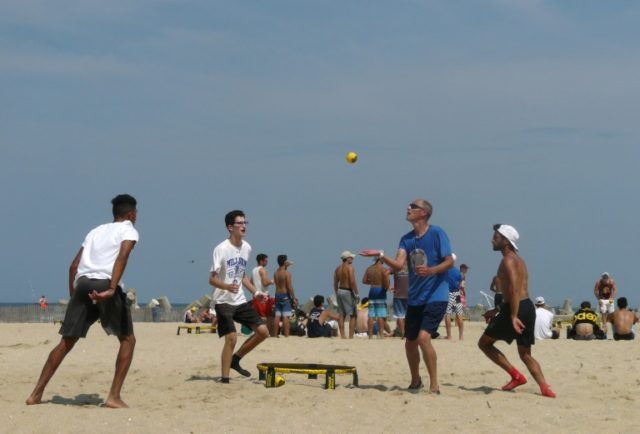New York (AFP) – For a game still in its infancy Spikeball — a beach sport which looks like the love child of volleyball and tennis — is already making global waves.
The rules are simple: each team of two must bounce a ball slightly larger than a tennis ball on a flat trampoline-type net 36 inches (91 centimeters) in diameter: about the size of a hula hoop.
Like in volleyball, a side can touch the ball a maximum of three times.
There are no boundaries, and a point is won when the opposing team fails to hit the ball back to the net.
In May, and again in July, the US sports channel ESPN2 even broadcast Spikeball tournaments — and the game has also spread to Europe and Canada.
It was created in the 1980s and original called Roundnet though its precise origins are unclear.
The concept was reborn in 2007 when a young Chicago entrepreneur named Chris Ruder began to sell gear for the game from his company named Spikeball.
Last fall he said he sold his millionth net and claims the company, which generated $15 million in sales in 2017, has since sold hundreds of thousands more.
“It’s definitely taken off like crazy in the past couple years,” said Steve Halek, a player at an official USA Spikeball tournament in late July at Point Pleasant, a seaside resort in New Jersey.
No fewer than 150 teams were registered for this year’s tournament, founded by Spikeball in 2013.
– ‘Anyone can play it’ –
Spikeball is a game “accessible to everyone. Anyone can play it,” said Halek.
“There are people that are ridiculously good but you can also play it in your backyard with your family.”
Halek said that Spikeball is “closer to tennis” than any other sport he knew, but others have said it also has a dash of Basque pelota and squash.
More than 2,500 teams signed up this season to play in official tournaments, with the grand finale scheduled for October in Santa Monica, California, said Jack Scotti, director of USA Spikeball.
Aside from the official tournaments there are hundreds of local tournaments organized this year with the support of Spikeball, which often contributes with gear and awards for the winners.
What separates Spikeball from other companies that make the same equipment is that “we have a community,” said Scotti.
“It’s… exposure and getting people to play the sport,” he said. “We’re pushing the sport.”
USA Spikeball has even created a “pro” division, though the winner of a tour event typically walks away with a few hundred dollars of prize money.
USA Spikeball wants to wants to preserve the popular side of sport, maintaining the festive and informal atmosphere that evokes a holiday camp for young adults — even though at this point most players are men.
“It’s a game that you can pick up really quickly,” said Scotti. “In one day, you could be addicted to it.”
Matt Pereira, who competed at the Point Pleasant tournament, described the game as “really unique,” and marveled that it had “no boundaries. So wherever the ball goes, the games goes. It’s very free.”
– Still evolving –
In Spikeball the angle the ball hits the net and coordination with your teammate are more important than speed or strength, players say.
Now that the game is starting to spread the globally, the challenge is to make sure it is more than just a passing fad.
To this end Ruder is busy organizing tournaments. He is having success at the college level, and is developing the game in high schools by sending kits and training PE teachers around the world.
For Scotti, with Spikeball “there’s always this next level, and the game is still evolving.”
Several players have been calling for the sport to be tweaked to prevent it becoming just a game dominated by powerful serves, a problem once suffered by tennis and something that Ruder acknowledges is “not very fun” to watch on TV.
Rule changes could include loosening the net.
If somehow the game can be played a bit slower, “it could be a sport that sticks around for a long time,” opined Spikeball veteran Jim Swanson.

COMMENTS
Please let us know if you're having issues with commenting.